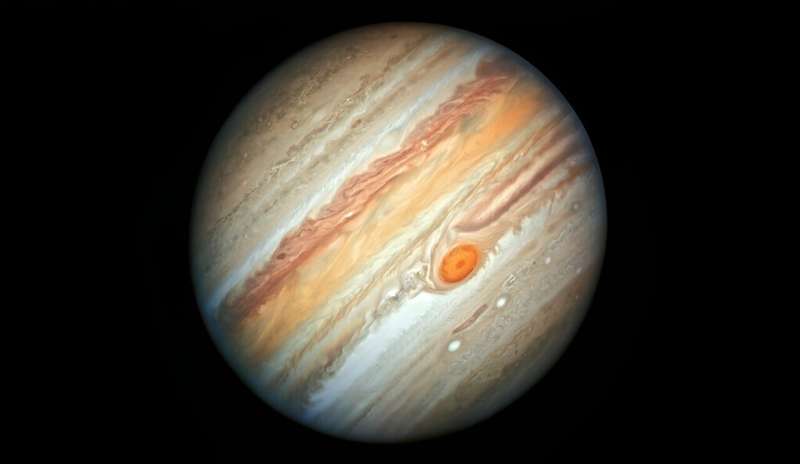This article has been reviewed according to Science X's editorial process and policies. Editors have highlighted the following attributes while ensuring the content's credibility:
fact-checked
peer-reviewed publication
trusted source
proofread
A new explanation for Jupiter's shrinking Great Red Spot

Jupiter's Great Red Spot—the biggest windstorm in the solar system—is shrinking, and a new study may help explain why.
Located in Jupiter's southern hemisphere, the Great Red Spot is a swirling, red-orange oval of high pressure more than 10,000 miles wide. It consistently blows more than 200 miles per hour in a counterclockwise direction, making it technically an anticyclone.
And it has been shrinking for the better part of a century, particularly over the past 50 years. While its latitudinal extent has remained relatively consistent, its longitudinal extent has contracted from 40 degrees in the late 19th century to 14 degrees in 2016, when NASA's Juno spacecraft arrived at the planet for a series of orbits.
"Many people have looked at the Great Red Spot over the last 200 years and were as fascinated by it as I am," said Caleb Keaveney, a Ph.D. student in Yale's Graduate School of Arts and Sciences and lead author of a new study in the journal Icarus.
"A lot of those people were not professional astronomers—they were just passionate and curious. That, plus the curiosity I see in people when I talk about my work, makes me feel like part of something bigger than myself."
Some of the curiosity relating to the Great Red Spot has to do with the many mysteries that surround it, despite the fact that it has been studied extensively. Astronomers don't know precisely when the spot formed, why it formed, or even why it is red.
For the study, Keaveney, who is part of Yale's Department of Earth & Planetary Sciences, and his co-authors, Gary Lackmann of North Carolina State University and Timothy Dowling of the University of Louisville, focused on the influence of smaller, transient storms on the Great Red Spot.
The researchers conducted a series of 3D simulations of the spot using the Explicit Planetary Isentropic-Coordinate (EPIC) model, an atmospheric model for planetary applications developed by Dowling in the 1990s. Some of these simulated interactions between the Great Red Spot and smaller storms of varying frequency and intensity, while another group of control simulations left out the small storms.
A comparison of the simulations suggested that the presence of other storms strengthened the Great Red Spot, causing the spot to grow larger.
"We found through numerical simulations that by feeding the Great Red Spot a diet of smaller storms, as has been known to occur on Jupiter, we could modulate its size," Keaveney said.
In part, the researchers based their modeling on long-lived high-pressure systems observed closer to home, in Earth's atmosphere. These systems—known as "heat domes," or "blocks"—occur regularly in the westerly jet streams that circulate across Earth's mid-latitudes and play a major role in extreme weather events such as heat waves and droughts.
The longevity of these "blocks" has been linked to interactions with smaller, transient weather mechanisms, including high pressure eddies and anticyclones.
"Our study has compelling implications for weather events on Earth," Keaveney said. "Interactions with nearby weather systems have been shown to sustain and amplify heat domes, which motivated our hypothesis that similar interactions on Jupiter could sustain the Great Red Spot. In validating that hypothesis, we provide additional support to this understanding of heat domes on Earth."
Keaveney said additional modeling will allow researchers to refine the new findings—and perhaps shed light on the Great Red Spot's initial formation.
More information: Caleb W. Keaveney et al, Effect of transient vortex interactions on the size and strength of Jupiter's Great Red Spot, Icarus (2024). DOI: 10.1016/j.icarus.2024.116196
Journal information: Icarus
Provided by Yale University



















